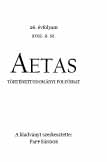Bethlen Gábor fejedelmi látogatásai Brassóban a városi számadáskönyvek tükrében
Gábor Bethlen’s visit in Brassó as reflected in the financial registers of the city
Author(s): Zsuzsanna CzirákiSubject(s): History
Published by: AETAS Könyv- és Lapkiadó Egyesület
Summary/Abstract: The paper discusses one of the most notable periods in the history of the Principality of Transylvania: the reign of Gábor Bethlen. Unusually, however, the focus is not on questions of political history, warfare or diplomacy but rather on an everyday event from the era of the Transylvanian princes, the reception of the Transylvanian ruler – in our case Gábor Bethlen – in one the most important towns of his country, Brassó. As an organic part of the princely services weighing on the Saxon towns, the prince’s visit was a fundamental component in the relationship between the Saxon communities and the prince. Accordingly, the details of the event can cast light on the actual relationship between the princely power and the Transylvanian Saxon communities. Moreover, this can augment our knowledge about the history, economic conditions and the life of the Saxon autonomy, and even about the town and court hierarchy of the era. The study is based on a specific group of sources, the financial registers of the city villicus (city officer responsible for the financials of the community), which are available from the years 1613–1617 and 1620–1629. On the basis of the entries and comments, we can draw a detailed and colorful picture of this extraordinary event: the visit of the prince. We learn about the ceremonial framework for the distinguished guest’s stay in Brassó, the organizationa ltasks the city needed to carry out as well as the town management mechanisms working in the background, and we can also have a glimpse of the eating habits in contemporary Brassó and the way of life of the locals. The data reveal such details that provide further additions to our knowledge about the relationship of the prince and the the privileged Saxon community, and bring us closer to understanding the everyday life of a 17th-century Central Eastern European municipal community.
Journal: AETAS - Történettudományi folyóirat
- Issue Year: 2011
- Issue No: 2
- Page Range: 5-31
- Page Count: 27
- Language: Hungarian

